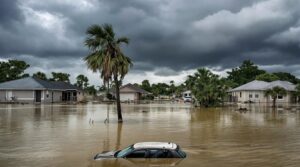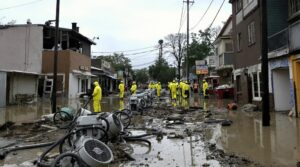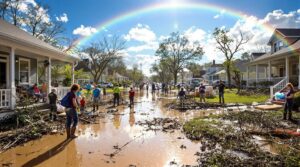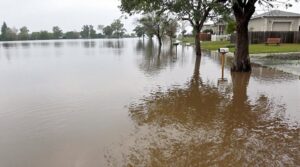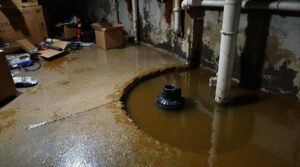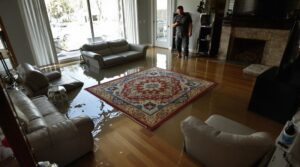After a flood, immediate safety steps include shutting off utilities and waiting for official clearance before re-entry. Essential first calls should go to the insurance company, restoration services, and a public adjuster for claim assistance. Documentation through photos and detailed notes remains vital for insurance purposes. Proper safety gear, including boots and masks, must be worn during initial assessment. Professional guidance through this complex process can greatly improve claim outcomes and recovery success.
Key Takeaways
- Immediately shut off electricity and gas, then contact your insurance company to report the incident and begin the claims process.
- Document all damage with clear photos and videos, maintaining detailed records for insurance claims and adjuster assessments.
- Remove standing water within 24-48 hours using pumps or wet vacuums, and start drying surfaces to prevent mold growth.
- Call a professional water damage restoration company for proper cleanup and a licensed plumber if flooding stems from plumbing issues.
- Consider hiring a public adjuster, as they typically secure 20-50% higher insurance claim settlements and manage documentation professionally.
Immediate Safety Steps After a Flood
When floodwaters recede from a residential area, homeowners must prioritize safety before attempting to return to their properties. The first vital step is waiting for official clearance from local authorities to guarantee the area is safe for re-entry.
Once permitted, residents should immediately shut off all electricity and gas at main valves to prevent potential hazards.
Before entering the property, homeowners must assess the structural integrity of their house, checking for signs of compromised walls, ceilings, or floors. Personal protection is necessary when inspecting flood damage; wearing appropriate safety gear such as boots, gloves, and masks helps guard against contaminated water and debris.
To support future insurance claims, thorough documentation of all damage through photographs and detailed notes is imperative. This documentation should begin immediately upon re-entry and include extensive records of visible damage throughout the property, creating an essential foundation for the claims process and subsequent repairs.
Understanding Water Damage Categories and Classes
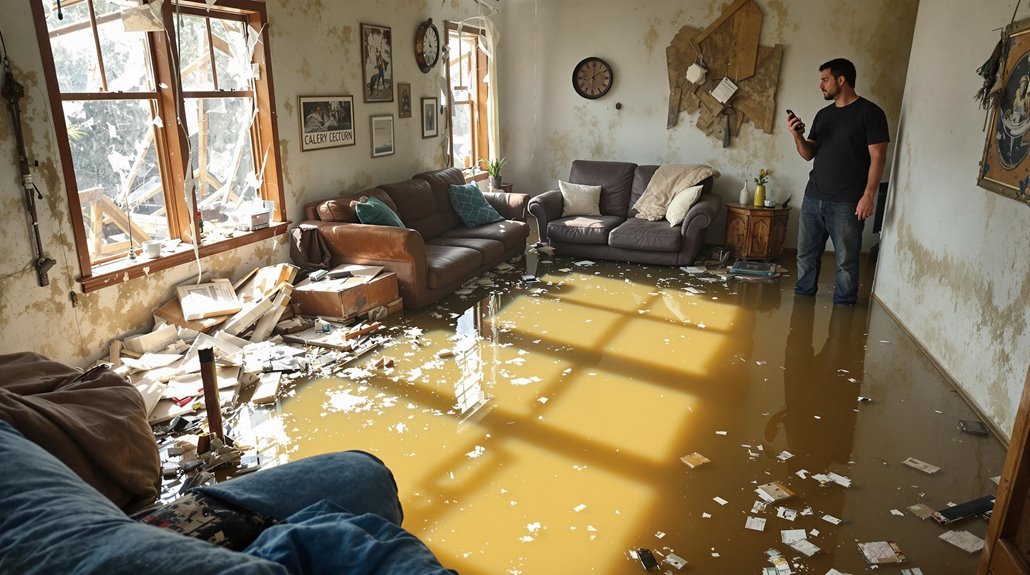
The proper assessment of water damage requires understanding its distinct categories and classes, which determine the severity of contamination and necessary restoration approaches.
Water damage is classified into three categories based on the source of water and contamination level, ranging from clean water to highly hazardous black water.
- Category 1 involves clean water from supply lines, typically covered by homeowners insurance cover.
- Category 2 comprises grey water with moderate contamination, such as dishwasher overflow.
- Category 3 consists of black water containing sewage or flood water, requiring specialized restoration.
Additionally, water damage is divided into four classes based on evaporation rates and affected materials. These classifications guide restoration professionals in determining appropriate drying techniques and equipment needed.
Understanding these distinctions is fundamental when filing an insurance policy claim, as coverage may vary depending on the water damage category and its source. This knowledge helps property owners make informed decisions about necessary restoration steps and potential coverage options.
Essential Phone Calls to Make First
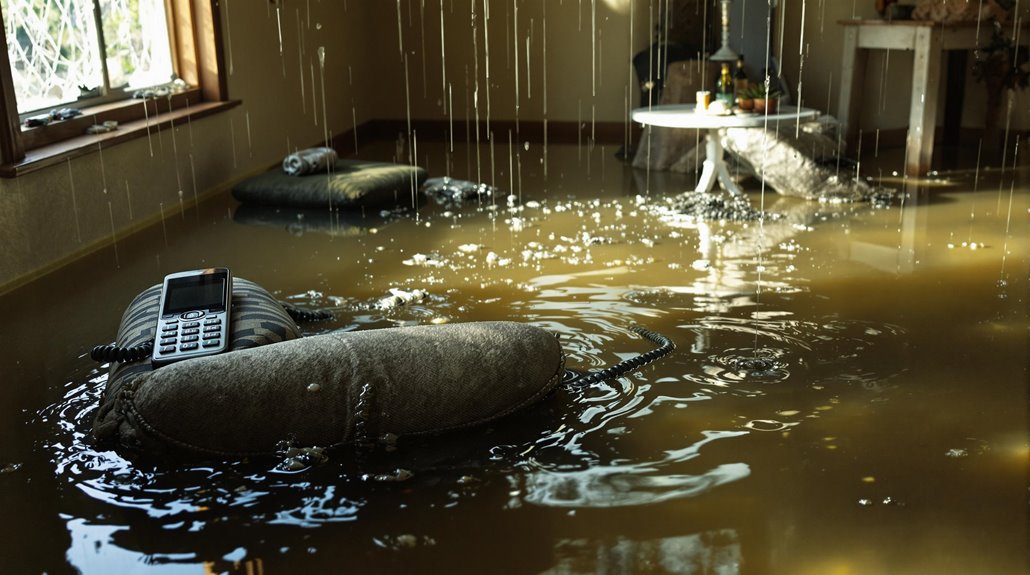
Several critical phone calls must be made immediately after discovering flood damage in a home to minimize property damage and initiate recovery procedures.
The first call should be to the insurance company to report the incident and begin the claims process, providing essential information including the homeowners policy number and detailed description of the flooding.
Local authorities should be notified if there are safety concerns related to structural integrity or utility hazards.
A professional water damage restoration company needs to be contacted promptly to assess the situation and remove standing water, preventing secondary damage and potential mold growth.
If the property is rented, the landlord must be informed of the flooding situation to enable appropriate property management actions.
Additionally, when flooding results from plumbing issues, securing the services of a licensed plumber is essential to address the root cause and implement preventive measures for future incidents.
Documenting Damage for Insurance Claims

When documenting flood damage for insurance claims, homeowners should begin by capturing extensive photographic and video evidence of all affected areas before moving or removing any items.
Each damaged item requires individual documentation, including detailed descriptions of the damage sustained and its location within the home at the time of flooding.
Creating this thorough visual and written record serves as essential evidence for insurance adjusters to assess the full scope of losses and determine appropriate compensation.
Take Photos First
Proper documentation through photographs and videos stands as a critical first step after discovering flood damage in a home.
When filing an insurance claim, visual evidence plays an essential role in substantiating the extent of losses and securing appropriate compensation.
Key steps for photographic documentation include:
- Capturing clear, well-lit images of all affected areas and damaged belongings
- Recording the date and time for each photograph to establish an accurate timeline
- Taking both wide-angle shots of entire spaces and close-up details of specific items
Professional documentation should include images of the water source and resulting damage patterns.
Homeowners must maintain a detailed log of all claim-related communications alongside their visual evidence.
This thorough approach to documenting damage helps guarantee a smoother insurance claims process and maximizes the likelihood of fair compensation.
Document Item by Item
Each damaged possession requires meticulous documentation to confirm thorough insurance coverage after a flood. Creating a detailed record of water damage helps expedite claims processing and guarantees proper damage restoration. Homeowners should maintain detailed documentation using the following systematic approach:
| Documentation Step | Action Required |
|---|---|
| Visual Evidence | Take clear photos of each item |
| Item Details | Record brand, model, serial numbers |
| Purchase Info | Note dates and original costs |
| Damage Assessment | Describe specific damage conditions |
| Value Estimation | List replacement or repair costs |
Beyond photographing items, maintaining a chronological record of the flood incident strengthens insurance claims. Include dates of discovery, professional assessments, and any immediate actions taken to prevent further damage. This systematic documentation helps insurance adjusters accurately evaluate the extent of losses and process claims efficiently.
Professional Water Damage Restoration Services
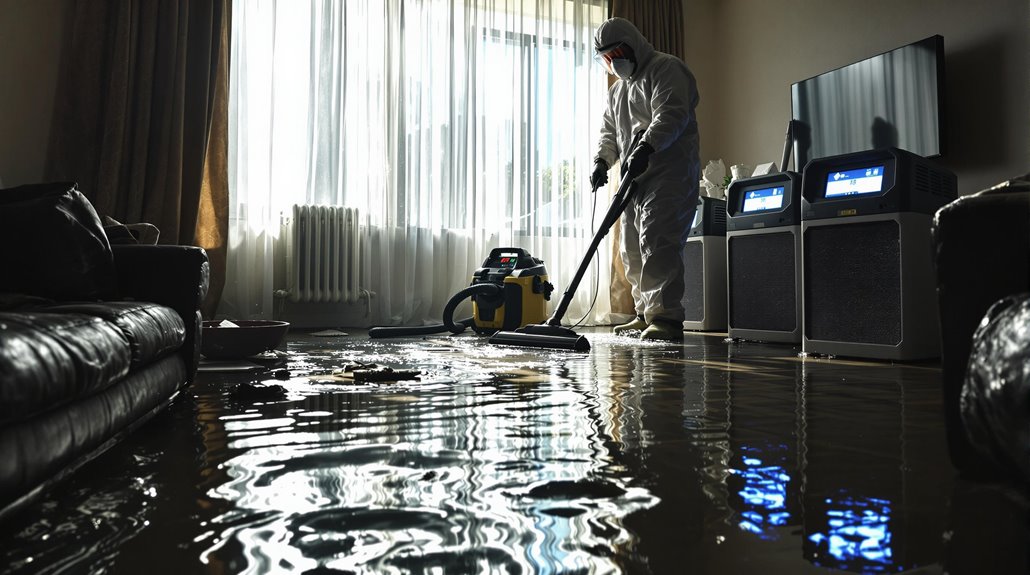
Following severe water damage, professional restoration services offer wide-ranging solutions using specialized equipment and industry-standard procedures to prevent long-term structural damage and health risks. Certified professionals follow strict IICRC standards while conducting thorough assessments using water sensing equipment to identify affected areas and water intrusion sources.
Key aspects of professional water damage restoration services include:
- Implementation of industrial-grade air movers and dehumidifiers to reduce moisture levels below 15%
- Systematic monitoring of drying progress every 24 hours to guarantee efficient remediation
- Detailed assessment and documentation for insurance information
Time is critical when dealing with water damage, as even minor leaks can release hundreds of gallons of water daily.
Professional intervention greatly reduces restoration costs and prevents secondary issues like mold growth. Through proper water extraction and monitoring techniques, restoration experts guarantee structures return to safe, habitable conditions while maintaining compliance with industry standards.
Working With Your Insurance Company
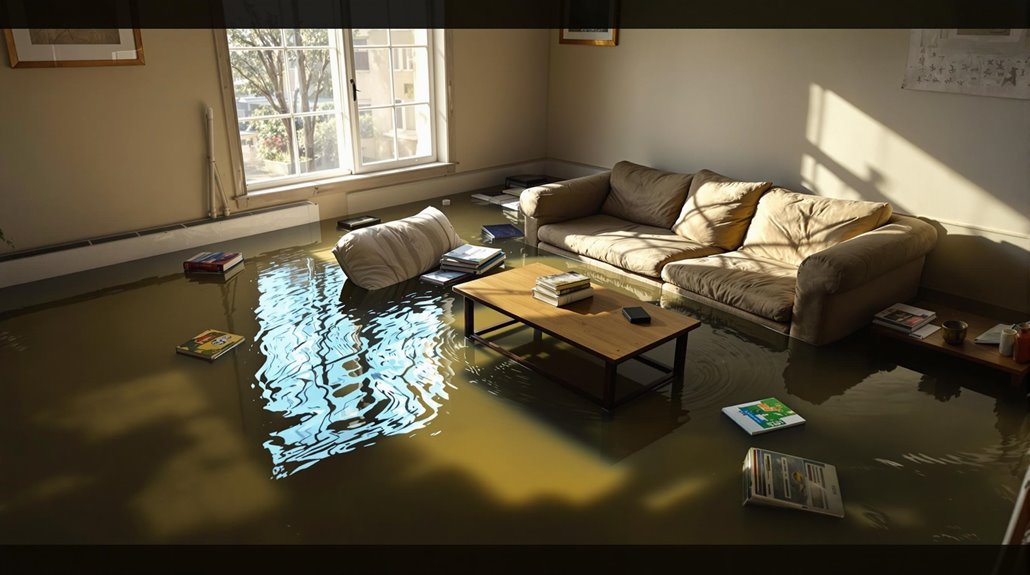
Maneuvering the insurance claims process after a flooding incident requires immediate action and meticulous documentation. Homeowners should contact their insurance company promptly, providing their policy number and a detailed description of the damage. Understanding insurance policies is vital, as standard homeowners insurance typically covers sudden water damage but may exclude flood damage, which often requires separate coverage.
| Action | Purpose | Outcome |
|---|---|---|
| Contact Insurance | Report incident | Initiate claim |
| Document Damage | Photo/video evidence | Support claim |
| Review Policy | Understand coverage | Know your rights |
| Meet Adjuster | Professional assessment | Verify damage |
| Keep Records | Track communication | Guarantee follow-through |
Before the adjuster's visit, thoroughly document the damage through photographs and videos. This evidence strengthens the claim and helps guarantee appropriate compensation. Maintain detailed records of all communications with the insurance provider, including dates, times, and names of representatives contacted. This organized approach facilitates a more efficient claims process and improves the likelihood of a satisfactory resolution.
Cleanup and Prevention of Secondary Damage

The immediate removal of standing water is critical in preventing secondary damage after a flood, and homeowners should utilize sump pumps or wet vacuums to efficiently extract water from affected areas.
Once standing water is eliminated, thorough drying of all surfaces and materials must begin within 24-48 hours to prevent mold growth and bacterial contamination.
Professional-grade dehumidifiers and air movers should be strategically placed to achieve ideal moisture reduction, while moisture meters can be used to monitor progress until affected areas reach a stable moisture content below 15%.
Remove Standing Water First
When flooding occurs in a home, immediate removal of standing water becomes the critical first priority to prevent extensive structural damage and potential health hazards.
Rapid water extraction within the first 24-48 hours is essential to prevent mold growth and minimize long-term damage to the structure and belongings.
Professional water removal equipment, such as sump pumps and wet vacuums, should be deployed immediately to efficiently extract standing water from the flooded house.
To guarantee proper drying:
- Create adequate airflow by opening windows and doors when weather permits
- Move water-damaged items to dry areas immediately, especially porous materials
- Monitor moisture levels with meters until readings fall below 15%
This systematic approach to water removal helps prevent secondary damage and creates conditions necessary for effective restoration of the affected space.
Dry Everything Thoroughly Now
Rapid and thorough drying of flood-affected areas stands crucial in preventing secondary damage and mold proliferation after water extraction.
The drying process must begin within 24-48 hours to prevent mold growth in water damage situations, particularly when dealing with clean water incidents.
Professional restoration requires strategic placement of air movers and dehumidifiers to reduce moisture levels effectively. Structural materials must achieve less than 15% moisture content to prevent microbial growth.
Remove saturated carpets, rugs, and furniture immediately, as these items can harbor bacteria and accelerate deterioration. Thorough cleaning and disinfection of affected surfaces is necessary, especially following grey or black water exposure.
Monitor drying equipment daily, tracking temperature and humidity levels to guarantee peak moisture reduction.
This systematic approach helps prevent long-term structural damage and health hazards.
Long-term Recovery and Repairs

Successfully managing long-term recovery after a flood requires meticulous attention to detail and a systematic approach to repairs. Homeowners must prioritize documentation of property damage and maintain detailed records of all repair estimates to maximize insurance company reimbursements. Taking immediate action helps prevent long-term damage and reduces restoration costs.
To guarantee effective recovery and implement measures to prevent future flooding, property owners should:
- Engage professional restoration services that utilize specialized psychrometric techniques and equipment
- Monitor humidity levels continuously, maintaining them below 15% to prevent mold growth
- Install protective measures such as sump pumps or flood barriers, especially given that 25% of flood claims occur in previously low-risk areas
The restoration process demands vigilant oversight, as 41% of homeowners experience water-related incidents. Professional assessment and thorough documentation of damages are essential for both immediate recovery and future protection against similar incidents.
Future Flood Prevention Strategies
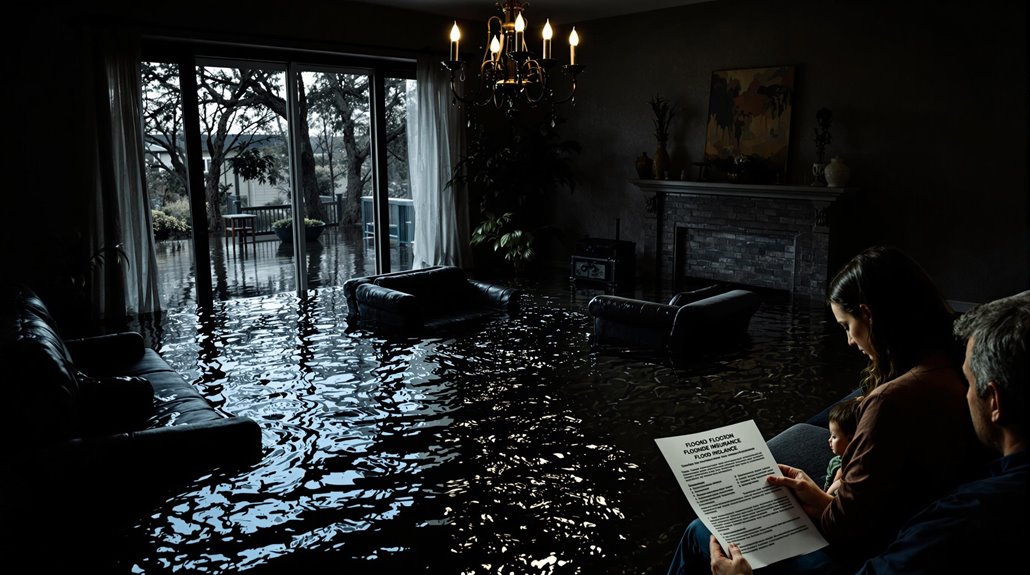
Implementing thorough flood prevention strategies can greatly reduce the risk of future water damage to homes and properties. Installing a sump pump and backflow valves provides essential protection against natural flooding, while elevating utility systems above potential flood levels guarantees continuous operation during emergencies.
| Prevention Method | Primary Benefit |
|---|---|
| Sump Pump Installation | Prevents basement water intrusion |
| Utility System Elevation | Maintains essential services during floods |
| Gutter Maintenance | Directs water away from foundation |
| Landscape Modifications | Improves water drainage management |
| Flood Insurance Coverage | Provides financial protection |
Homeowners should complement these mechanical solutions with proper landscape management. Installing swales or rain gardens helps absorb excess rainwater, while regular gutter and downspout maintenance prevents water from pooling near the foundation. Additionally, securing appropriate flood insurance coverage is vital, as flooding can occur even in low-risk areas. Understanding available coverage options guarantees all-encompassing protection against future water damage.
The Benefits Of Consulting A Public Adjuster
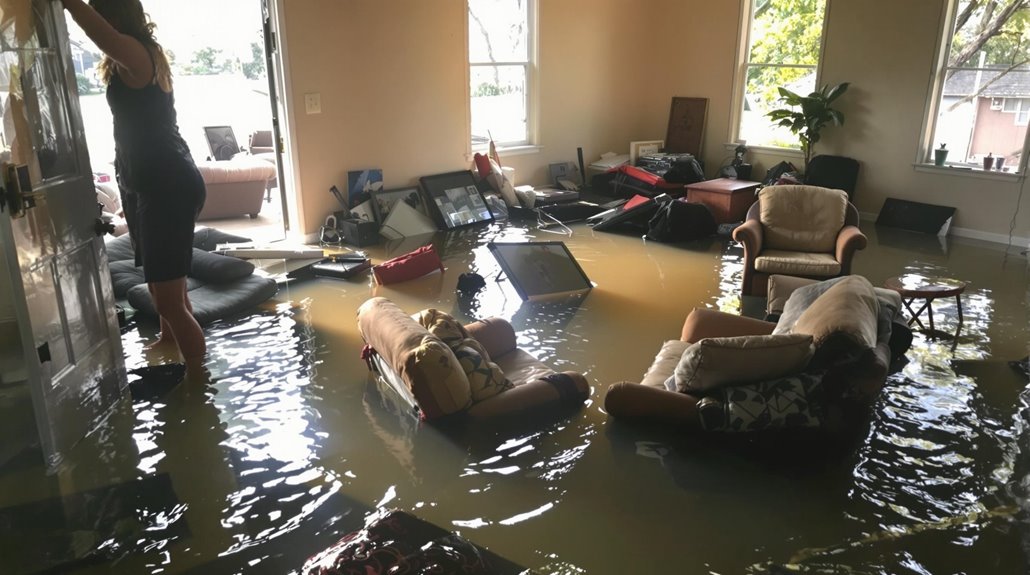
When facing flood damage, consulting a licensed public adjuster can provide invaluable expertise in maneuvering complex insurance claims and evaluating property damage objectively.
Public adjusters streamline the claims process by thoroughly documenting losses, preparing extensive claims packages, and managing all communications with insurance companies.
Studies indicate that policyholders who engage public adjusters often receive notably higher settlement amounts, with some cases showing increases of up to 800% compared to unrepresented claims.
Expertise In Insurance Claims
Professional handling of flood-related insurance claims often requires specialized expertise, making public adjusters valuable allies during the recovery process.
These specialists possess extensive knowledge of home insurance policies and understand the intricate details of flood damage coverage.
Public adjusters offer distinct advantages in managing insurance claims:
- They analyze policies thoroughly to identify all applicable coverage options, ensuring maximum compensation for flood-related damages.
- Their expertise in documentation and evidence collection strengthens claim submissions.
- They negotiate directly with insurance companies, leveraging their industry knowledge to secure ideal settlements.
Operating on a contingency fee basis, public adjusters align their interests with the policyholder's success.
Their professional oversight not only streamlines the claims process but often results in higher settlement amounts compared to self-managed claims.
Objective Damage Assessment
A thorough objective damage assessment conducted by a public adjuster provides homeowners with an exhaustive evaluation that often reveals hidden damages and long-term consequences of flooding.
Public adjusters bring specialized expertise to the assessment process, identifying issues that homeowners might overlook, such as structural weaknesses, potential mold growth, and building code compliance requirements.
Their extensive evaluations typically result in settlement amounts averaging 40% higher than claims handled without professional assistance.
These insurance specialists work exclusively for the policyholder's benefit, ensuring that every aspect of the damage is documented and properly valued.
Streamlined Claim Process
Working with a public adjuster greatly expedites the flood insurance claims process while maximizing potential settlements for homeowners.
These professionals operate on a contingency fee basis, ensuring their interests align with achieving ideal claim results for their clients.
Key advantages of enlisting a public adjuster include:
- Professional management of all insurance company communications and documentation
- Expert interpretation of insurance policy terms related to water damage coverage
- Thorough assessment and documentation of flood-related damages
Statistical data indicates that policyholders who utilize public adjusters receive 20-30% higher settlements compared to those handling claims independently.
Their expertise in maneuvering complex insurance policies and understanding specific coverage types proves invaluable during the streamlined claims process, making them an essential resource for homeowners dealing with flood damage.
Higher Claim Payouts & Settlements
Statistical evidence consistently demonstrates that engaging a public adjuster leads to substantially higher insurance settlements for flood-damaged homes. Studies indicate homeowners receive 20-50% more in claim payouts when utilizing these professionals. Public adjusters maximize potential reimbursements through their expertise in policy interpretation and extensive damage documentation.
| Benefit | Impact | Value |
|---|---|---|
| Settlement Increase | 20-50% Higher | Significant Financial Gain |
| Expert Negotiation | Insurance Companies | Better Terms & Coverage |
| Documentation | Complete Assessment | Full Damage Recognition |
| Policy Knowledge | Coverage Details | Maximum Claim Potential |
While public adjusters charge 5-15% of the settlement, this fee is typically offset by the increased compensation they secure. Their professional expertise guarantees thorough claim evaluation, leading to more favorable outcomes for homeowners facing flood-related damages.
About The Public Claims Adjusters Network (PCAN)
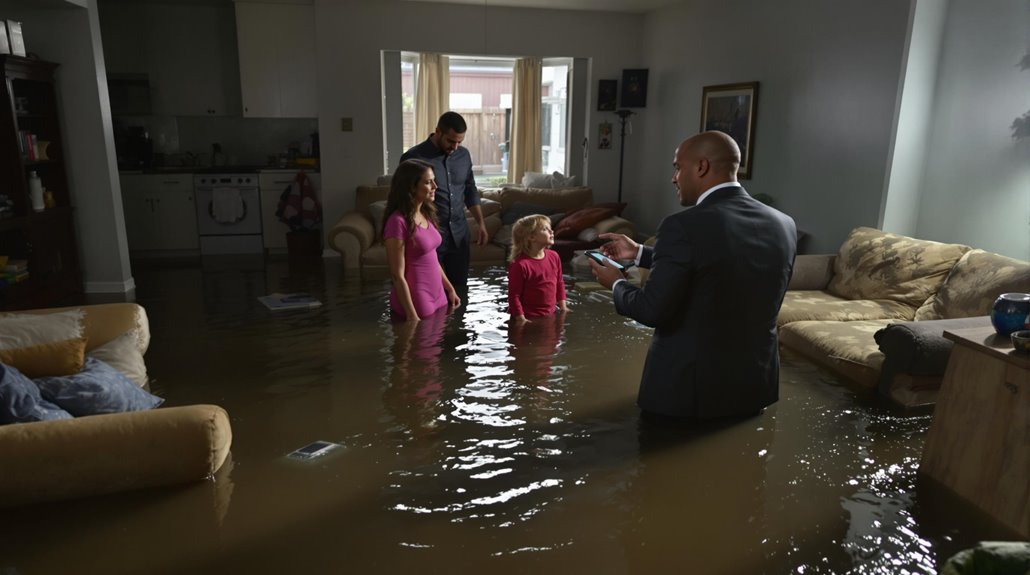
The Public Claims Adjusters Network (PCAN) operates as a nationwide organization connecting policyholders with licensed, pre-vetted public adjusters across 40+ states. This network specializes in both residential and commercial property damage insurance claims, with member adjusters qualified to handle over 30 different claim types.
PCAN maintains strict standards through:
- Intensive application and interview process for all member adjusters
- Mandatory yearly audits of licenses and complaint records
- Highest standards of ethics, morals, and professionalism
When property owners face damage caused by flooding or other disasters, finding a certified professional to handle insurance claims becomes essential.
PCAN serves as a valuable resource, ensuring policyholders connect with experienced public adjusters who have demonstrated expertise in their field. The network's rigorous vetting process and ongoing monitoring system help maintain the quality and reliability of their member adjusters, providing peace of mind to property owners during challenging times.
Frequently Asked Questions
Does House Insurance Cover Flooding?
Standard homeowners insurance excludes flood damage coverage. Separate flood insurance is required for flood damage assessments and protection. Extensive flood insurance basics include building and contents coverage through NFIP or private insurers.
Will Insurance Pay to Replace the Entire Floor?
Like traversing a maze, insurance coverage for floor replacement hinges on policy details, damage assessment findings, and material costs. Coverage typically extends to entire floors when matching is necessary.
What to Do Immediately After a Flood?
Emergency response after flooding requires immediate safety precautions: wait for official clearance, shut off electricity, document damage, contact insurance, and begin flood cleanup quickly to prevent mold development.
Who to Call When You Have a Flood?
Like Noah preparing for rising waters, immediate calls should be made to emergency services, insurance providers, local contractors, plumbers, and water damage restoration specialists for extensive flood response.
Final Thoughts
According to FEMA, just one inch of floodwater can cause up to $25,000 in damage to a home. Understanding proper flood response protocols, from immediate safety measures to insurance claims, is vital for minimizing losses and ensuring successful recovery. By following professional guidance, documenting thoroughly, and working with qualified experts like public adjusters, homeowners can navigate the complex restoration process more effectively and protect their investment.
For homeowners dealing with flood damage or any other property damage covered by their homeowners insurance policy, insurance industry insiders and legal experts strongly advise contacting a qualified state-licensed public adjuster for damage or loss insurance claims. Public adjusters work exclusively for the policyholder's benefit, not the insurance company, serving as invaluable advocates during the claims process. These state-licensed professionals help navigate complex insurance policies, identify hidden damages often unknown to policyholders, thoroughly document losses, and negotiate with insurance companies to ensure fair settlements while protecting policyholder rights. By working with a public adjuster, homeowners can maximize their claim payouts, accelerate the claims process, and reduce the stress of dealing with insurance companies, allowing them to focus on recovery. Policyholders interested in discussing their property damage claims can request a no-obligation free consultation with a Public Claims Adjusters Network (PCAN) member public adjuster.
